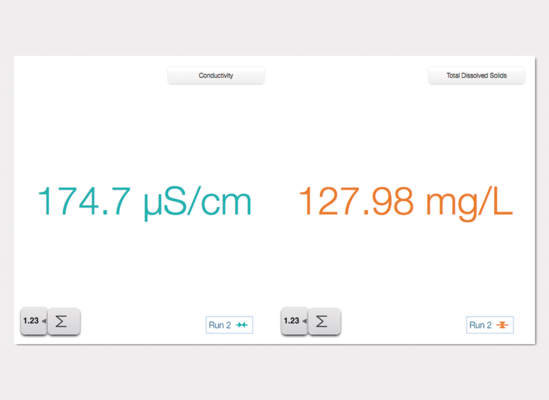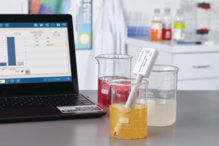











This waterproof sensor connects via Bluetooth® to measure both conductivity (ionic content in solution) and total dissolved solids.
- 1x Coin cell battery
See the Buying Guide for this item's required, recommended, and additional accessories.
Product Summary
The Wireless Conductivity Sensor has an improved range and decreased error when measuring the electrical conductivity of aqueous solutions. It is ideal for investigating the ionic properties of solutions, including calculations for total dissolved solids (TDS) often used for water quality inquiry. Temperature compensation handles calibrations across a range of temperatures. New design supports a doubling of previous conductivity determination, now up to 40,000 µS/cm, this sensor can be utilized for chemical, biological, and environmental studies easily into brackish waters.
Teacher tip: To measure fully marine samples above sensor range, dilute your salt water solution in half then multiply sample conductivity x 2.
Features
- Measure conductivity and total dissolved solids
- Automatic temperature compensation
- Battery life >1 year
- Remote logging with built-in memory
- Dust-proof, sand-proof, and water-resistant (1 meter for 30 minutes)
Applications
- Water quality investigations
- Performing condumetric titrations
- Investigating solution properties
- Diffusion of ions through membranes
- Differences between ionic and molecular compounds
- Comparing strong and weak acids
How It Works
Conductance is the reciprocal of resistance. In this case, the Wireless Conductivity Sensor measures the current flowing through the circuit when submerged in solution and voltage is applied. The electrode cell is constructed from insulating material with two pins made of 300 series stainless steel placed a fixed distance apart to serve as the sensing element. The Wireless Conductivity Sensor includes built-in temperature compensation to extend the useful range an minimize the need for calibration.
What's Included
- 1x Coin cell battery
Product Specifications
| Conductivity |
|
| Total Dissolved Solids |
|
| Response Time | 95% of final reading in 5 seconds or less |
| Probe Environmental Tolerance (Min-Max) | 0–80°C |
| Temperature Compensation | 0–35°C |
| Temperature Accuracy | ±0.5°C |
| Waterproof | IPX7 rated (1 meter for 30 min) |
| Connectivity | Bluetooth 5.2 |
| Logging | Yes |
| Battery Type | Coin Cell |
Battery & Logging
| Stored Data Points Memory (Logging) 1 | >35,000 |
| Battery - Connected (Data Collection Mode) 2 | >195 hr (2-3yrs of normal classroom use) |
| Battery - Logging (Data Logging Mode) 3 | >3 days |
| Battery Type | Coin Cell |
1 Minimum # of data points with all measurements enabled, actual results depend on enabled measurements.
2 Continuous use in a connected state until battery failure, actual results will depend on sample rate, active measurements, and battery condition.
3 Logging until battery failure, actual results will depend on sample rate, active measurements, and battery condition.
* Normal classroom use is the sensor in active use for 20min/lab for 120 lab periods/yr.
Data Collection Software
This product requires PASCO software for data collection and analysis. We recommend the following option(s). For more information on which is right for your classroom, see our Software Comparison: SPARKvue vs. Capstone »
Connectivity Options
This product can connect directly to your computer or device with the following technologies. No Interface required. See the following guide for details regarding device compatibility: Wireless Bluetooth Product Compatibility »
Dedicated Datalogging with SPARK LXi2
Consider an all-in-one, touchscreen data collection, graphing, and analysis tool for students. Designed for use with wired and wireless sensors, the SPARK LXi2 Datalogger simultaneously accommodates up to five wireless sensors and includes two ports for blue PASPORT sensors. It features an interactive, icon-based user interface within a shock-absorbing case and arrives packaged with SPARKvue, MatchGraph!, and Spectrometry software for interactive data collection and analysis. It can additionally connect via Bluetooth to the following interfaces: AirLink, SPARKlink Air, and 550 Universal Interface.
Buying Guide
| Recommended Accessories | P/N | Price |
|---|---|---|
| Electrode Support | PS-3505 | -- |
| Replacement Parts | P/N | Price |
|---|---|---|
| Coin Cell Battery Pack | PS-3504 | -- |
| Also Available | P/N | Price |
|---|---|---|
| USB Bluetooth Adapter | PS-3500 | -- |
Product Guides & Articles
AP Biology Lab Manual Overview
PASCO’s award-winning teacher guide, Advanced Biology Through Inquiry Teacher Lab Manual, includes eighteen guided inquiry labs that cover AP Biology concepts such as osmosis and diffusion, evolution, energetics, and system interactions.
AP Chemistry Lab Manual Overview
Authored by chemistry educators, the Advanced Chemistry Through Inquiry Teacher Lab Manual includes sixteen guided inquiry labs that cover AP Chemistry course concepts such as Moles and Molar Mass, Stoichiometry, and Reaction Rates.
Titration
A titration is a chemical analysis in which a researcher determines the concentration of a chemical solution (analyte or titrand) by adding a measured volume of standard solution (titrant) until the produced reaction reaches the equivalence point.
Experiment Library
Perform the following experiments and more with the Wireless Conductivity Sensor.
Visit PASCO's Experiment Library to view more activities.
Types of Bonding
Students use a Conductivity Sensor to predict the type(s) of bonding between atoms in solutions made with different substances.
Monitoring Water Quality
In this lab, students use a water quality sensor, turbidity sensor, and weather/anemometer sensor to monitor the pH, dissolved oxygen content, conductivity, and turbidity of a natural body of water. Students will use their data...
Water and pH
In this lab, students will investigate the conductivity and pH of local water sources before determining the buffering capacity of each sample using a weak acid.
A Chemistry Mystery: Name That Unknown!
Students use several methods to characterize compounds according to the nature of intramolecular bonding.
Stoichiometry Of Solutions
In this lab, students use a drop counter, conductivity sensor, and a temperature sensor to determine the concentration of dissolved ions by titration.
Modeling an Ecosystem
In this lab, students use a variety of sensors to explore the use of terrariums as a closed system for environmental studies and design methods for exploring the interrelationships of biotic and abiotic variables within ecosystems.
Physical or Chemical Change
Students use a pH Sensor, a Conductivity Sensor, and a Temperature Sensor to collect evidence that supports their conclusion about whether a chemical or physical change has occurred.
Drinking Water Quality: Hardness
How are total dissolved solids (TDS) measurements used to evaluate drinking water quality? In this investigation, students use a conductivity sensor to relate total dissolved solids (TDS) measurements with drinking water quality....
How Hard is Your Tap Water?
Students use conductometric titration and gravimetry to determine how much calcium carbonate is in a sample of tap water.
Properties of Ionic and Covalent Compounds
In this lab, students use a conductivity sensor to determine if an unknown substance is an ionic, polar covalent, or non-polar covalent compound.
Project: Design a Purification Process
Students must engineer a system to purify water that contains macroscopic and microscopic contaminants and evaluate the effectiveness of their design using a condenser, turbidity sensor, conductivity sensor, and qualitative observations.
Modeling Chemistry
In this lab, students use temperature, pH, and conductivity sensors to explore chemical and physical changes and analyze them for ambiguity. This lab helps students improve their understanding of sensors and representing reactions...
Support Documents
| Manuals | ||
|---|---|---|
| Wireless Conductivity Sensor Manual (PS-3210) | English - 378.08 KB | |
| Wireless Conductivity Sensor Manual (PS-3210A) | English - 741.96 KB | |
| Safety Sheets | ||
| Lithium Battery Safety Data Sheet | English - 129.01 KB | |
| Knowledge Base | ||
| How do I troubleshoot connecting a wireless sensor? | Aug 22nd, 2022 | |
| Windows asks for a PIN number when connecting wireless sensor or device | Sep 18th, 2023 | |
| Android asks for a PIN number to pair a wireless device to system | Aug 29th, 2023 | |
| How to install the Data Streamer app extension within Microsoft Excel | Apr 5th, 2023 | |
| Proper preparation of coin cells for recycling | Dec 12th, 2022 | |





















